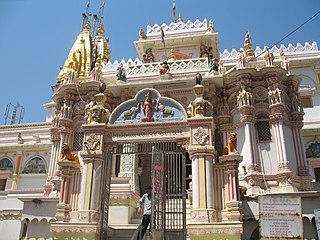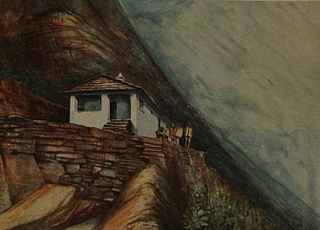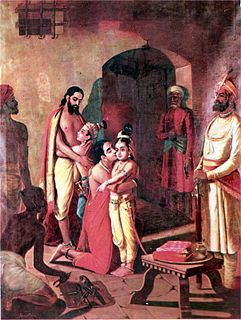Swaminarayan Sampraday, formally called Uddhav Sampraday, is a Hindu sect propagated by Swaminarayan. Swaminarayan was handed the leadership of the Uddhav Sampraday by his guru Ramanand Swami to continue to propagate the teachings and philosophy of Vishishtadvaita, which originates from the Sri Sampradaya. His main teaching was that Sri krishna purushottam narayan the resider of akshardham at midst of golok is supreme and should alone be worshipped
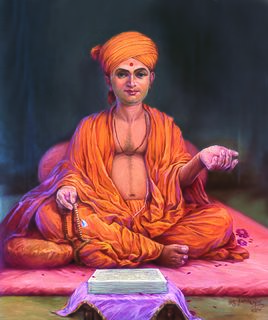
Gunatitanand Swami was a prominent paramhansa of the Swaminarayan Sampraday who was ordained by Swaminarayan and is accepted as the first spiritual successor of Swaminarayan by the Bochasanwasi Akshar Purushottam Swaminarayan Sanstha (BAPS) sect. Born into a religious family in Bhadra, a small farming community in the state of Gujarat, India, he first received religious education under his father's guru, Ramanand Swami before encountering Swaminarayan and becoming a sadhu under him at the age of 25. He was revered for his spiritual discourses and divine service.
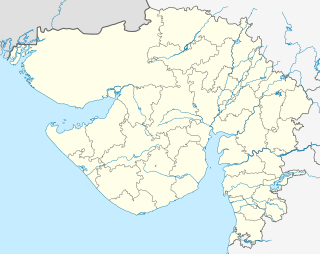
Botad is a city and district headquarters of Botad district, Gujarat, India. It is about 92 km from Bhavnagar and 133 km From Ahmedabad by road distance.

Shri Swaminarayan Mandir, Mumbai(Marathi: श्री स्वामीनारायण मंदिर, मुंबई) is a Hindu temple (Mandir) and a part of the Swaminarayan Sampraday. This Swaminarayan Temple is located in the Bhuleshwar area of Mumbai and is the oldest Swaminarayan Mandir in Mumbai, being over a hundred years old.
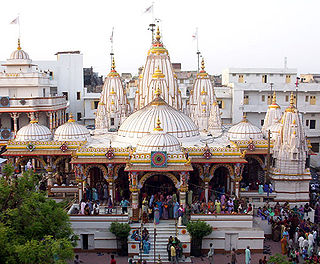
Shree Swaminarayan Mandir Kalupur is the first temple of the Swaminarayan Sampraday, a Hindu sect. It is located in Kalupur area of Ahmedabad, the largest city in Gujarat, India. It was built on the instructions of Swaminarayan Bhagwan, the founder of the sect.

Shri Swaminarayan Mandir, Vadtal headquarters of the Shri LaxmiNarayan Dev Gadi are located in this temple in Vadtal. There are three main shrines in the temple the central shirne of this temple is that of Lakshmi Narayan and RanchodRaiji. On the right there is an image of Radha Krishna with Swaminarayan in the form of Hari Krishna and the left has Vasudev, Dharma and Bhakti. The wooden pillars of the temple bear colourful wood carvings. There is a dharamsala within the temple premises. Gnyanbaug is a garden to the northwest of the temple gate that has four memorials dedicated to Swaminarayan. vadtal swaminarayan temple now declared as a pilgrim center by government of Gujarat and to be part of shrines recognized by Gujarat's Pavitra Yatradham Vikas Board, announced by Gujarat's Chief Minister Vijay Rupaniji.

Shri Swaminarayan Mandir, Bhuj is a Hindu temple in Bhuj. This temple (mandir) that was constructed by lord Swaminarayan, founder of the Swaminarayan Sampraday.

Shri Swaminarayan Mandir, Dholera is a Hindu temple in Dholera, India, and is one of six Shri Swaminarayan Temples built by Swaminarayan.

Muli is a town located 21 km southwest of the district capital of Surendranagar, Gujarat, India, by the Bhogavo River. It has a population of greater than 20,000 people

Satsangi Jeevan is the authorised biography of the Bhagavaan Swaminarayan. The book contains information on the life and teachings of Swaminarayan. IIt is written by Shatanand Swami and completed in 1829. Swaminarayan decided to make Gadhada his permanent residence on the insistence of Dada Khachar and his sisters. Upon completion of the Shri Swaminarayan Mandir, Gadhada in 1828, Swaminarayan instructed Shatanand Swami to write a book on his life and pastimes.
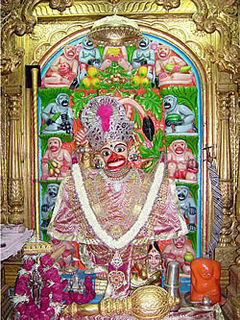
Shri Hanuman Mandir, Sarangpur is a Hindu temple located in Sarangpur, Gujarat and comes under the Vadtal Gadi of the Swaminarayan Sampraday. It is the only Swaminarayan Temple which does not have the Murtis of either Swaminarayan or Krishna as the Primary deity of worship. It is dedicated to Hanuman in the form of Kastbhanjan.
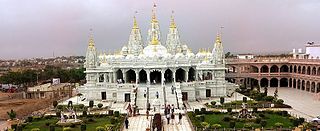
Shri Swaminarayan Mandir is a temple complex in Bhuj, Kutch district, Gujarat which is managed by Nar Narayan Dev Gadi of the Swaminarayan Sampraday, a sect of Hinduism. The inauguration ceremony of the temple held from 15 to 23 May 2010.

Gir Gadhada is a mid city town in Gir Somnath district in the state of Gujarat, India. Before 2013, it was a village of Una Taluka in Junagadh District, Now it has become the administrative headquarters for 42 villages when that taluka was created as part of the new Gir Somnath District in August of that year. Newly built BAPS Shree Swaminarayana Mandir is a popular place of worship and spiritual activities here. There is another older Swaminarayan mandir nearby. Other temples in the town are Shree Khodiyar Mandir and Shree ramji Mandir.

Botad District is a district of the state of Gujarat, India. It was created on 15 August 2013 from the southwestern part of Ahmedabad District and the northwestern part of Bhavnagar District. Botad consist of four taluka Botad, Gadhada, Barvala, Ranpur. Botad city is the administrative headquarters of the district.

Shri Swaminarayan Mandir is located near Tithal town of Valsad district of Gujarat. The temple is located on the shore of the beach of Tithal. The temple's construction was started in 1991. The temple is made for worshipping Lord Swami Narayan. The temple was inaugurated by Shree Pramukh Swami. The temple is administrated by BAPS.

